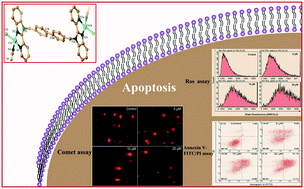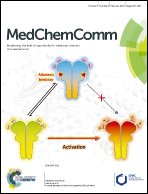DNA interactions and in vitro anticancer evaluations of pyridine-benzimidazole-based Cu complexes†
Abstract
Copper is an essential element and has redox potential, thus copper complexes have been developed rapidly with the hope of curing cancer. To further develop anticancer agents and investigate their anticancer mechanisms, two Cu complexes, [Cu(bpbb)0.5·Cl·SCN]·(CH3OH) (1) and [Cu2(bpbb)·Br3·(OH)]n (2), were synthesized and characterized using 4,4′-bis((2-(pyridin-2-yl)-1H-benzo[d]imidazol-1-yl)methyl)biphenyl (bpbb), with associated Cu(II) salts. Complex 1 is a binuclear structure, whereas 2 is a one-dimensional complex. Compared with 2, complex 1 exhibited potent in vitro cytotoxicity toward four cell lines (HCT116, BGC823, HT29, and SMMC7721), and was most effective against HCT116 cells. Therefore, further in-depth investigation was carried out using complex 1. Absorption spectral titration experiments, ethidium bromide displacement assays, and circular dichroism spectroscopic studies suggested that complex 1 binds strongly to DNA by intercalation. Complex 1 exhibited a clear concentration-dependent pBR322 DNA cleavage activity. Inductively coupled plasma mass spectrometry testing implied that complex 1 could enter cells and that DNA was one important target. Cellular level assays suggested that complex 1 activates the generation of intracellular reactive oxygen species, causing DNA damage, promoting cell cycle arrest and mitochondria dysfunction, and inducing cellular apoptosis.



 Please wait while we load your content...
Please wait while we load your content...